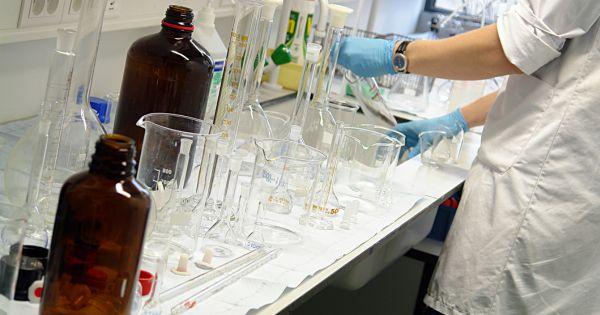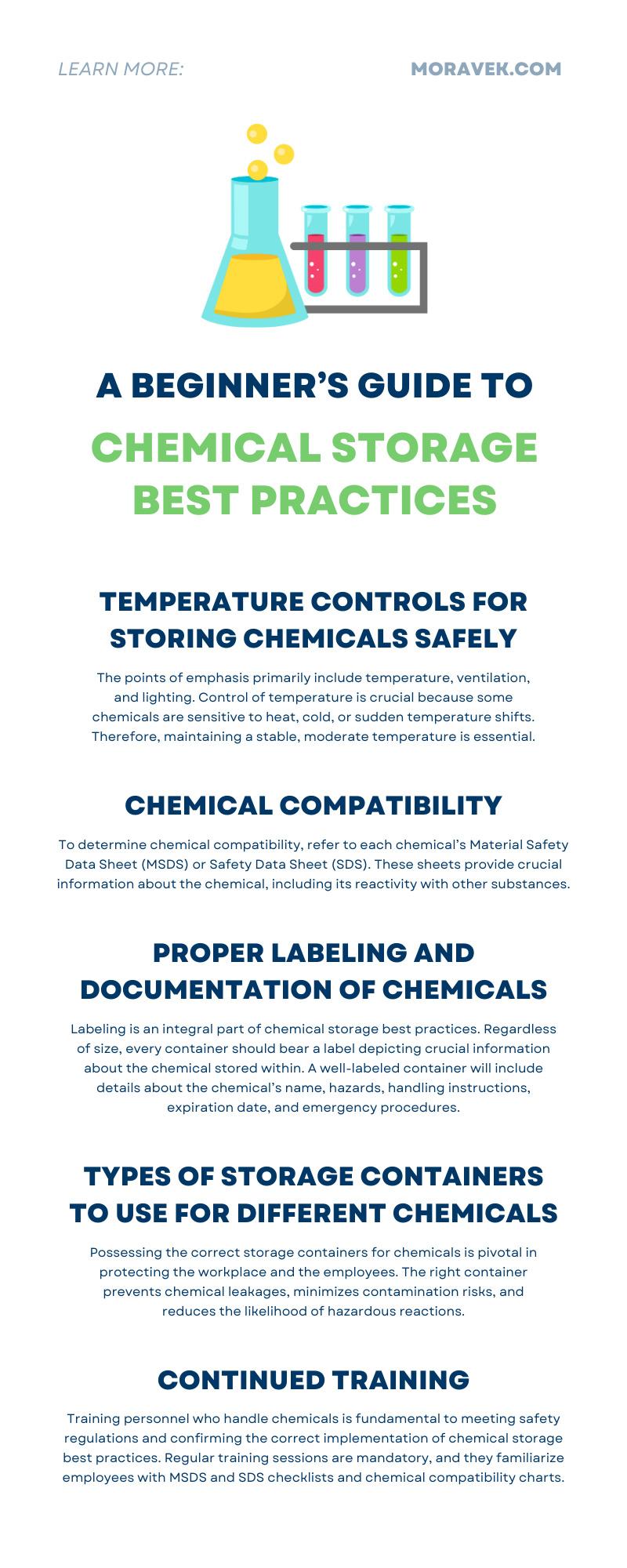
Working around chemicals is something that doesn’t have any shortcuts. Accidents involving chemicals are very hazardous, sometimes lethal, and often quite expensive. Workplace mistakes can cause damage to the equipment, the destruction of the project, and the loss of chemicals. The good news is that it is feasible to avoid these chemical catastrophes by following this beginner’s guide to chemical storage best practices.
Federal, State, and Local Regulations
Before we dive head first into the best practices, it’s a good idea to understand the laws set forth for chemical storage. Adherence to federal, state, and local chemical storage regulations is paramount to maintaining a safe working environment.
In the US, the Occupational Safety and Health Administration (OSHA) declares guidelines for storing and handling chemicals. Their standards in Title 29 of the Code of Federal Regulations (CFR) provide a comprehensive framework for identifying, managing, and communicating chemical hazards.
State regulations may vary, but they generally include provisions specific to that state’s industries and environments. They may also elaborate on federal guidelines, providing more detailed requirements for certain chemical storage and handling aspects. It is essential to consult with state regulatory agencies to ensure full compliance.
Local regulation can encompass county or city ordinances, often focusing on zoning, fire safety, and environmental protection. These regulations might dictate where employees can store chemicals, what fire prevention measures must be in place, and how to prevent chemical leaks from affecting local ecosystems.
Reviewing these regulations is important, as they are subject to change regularly. Non-compliance can result in hefty penalties and serious safety hazards. Thus, understanding and following all applicable chemical storage regulations is crucial.
Temperature Controls for Storing Chemicals Safely
The laws set the parameters of doing the bare minimum regarding chemical storage. However, there are many things you need to consider outside of compliance with the law.
One of the foremost considerations for effective chemical storage is confirming your storage area has the right conditions. The points of emphasis primarily include temperature, ventilation, and lighting. Control of temperature is crucial because some chemicals are sensitive to heat, cold, or sudden temperature shifts. Therefore, maintaining a stable, moderate temperature is essential.
Stored chemicals should avoid direct sunlight, moisture, and heat. Direct sunlight can react with some chemicals, creating volatile and dangerous situations. Moisture and heat conditions can accelerate the rate of chemical degradation and alter the chemical properties over time.
Proper ventilation will help to disperse any fumes that may build up, preventing harmful exposure and potential explosions. Ergo, verifying your storage area has a temperature and humidity monitoring system and adequate ventilation through frequent checks is paramount.
Chemical Compatibility
A key aspect of safe chemical storage is knowing your chemicals and their compatibility. This means understanding how different chemicals react when they come into contact. Some chemicals, when mixed, can cause dangerous reactions, including fire, explosion, or the production of toxic gases.
To determine chemical compatibility, refer to each chemical’s Material Safety Data Sheet (MSDS) or Safety Data Sheet (SDS). These sheets provide crucial information about the chemical, including its reactivity with other substances.
In addition to the MSDS or SDS, numerous chemical compatibility charts are available online that can provide quick information about common substances. However, you should always cross-check this information with the official data sheets for your chemicals.
Consider segregating incompatible chemicals in separate storage cabinets or using secondary containment trays. This way, even if a container becomes compromised, you minimize the chance of incompatible chemicals mixing. By understanding your chemicals and their compatibility, you can greatly enhance the safety and efficiency of your storage practices.
Proper Labeling and Documentation of Chemicals
Labeling is an integral part of chemical storage best practices. Regardless of size, every container should bear a label depicting crucial information about the chemical stored within. A well-labeled container will include details about the chemical’s name, hazards, handling instructions, expiration date, and emergency procedures.
This labeling system facilitates the easy identification of substances and helps prevent accidental misuse or dangerous combinations of chemicals. Additionally, labels remind us of the safety measures we must adhere to while handling these chemicals. Storage facilities also have to follow the legal requirements we discussed.
Ultimately, proper chemical labeling plays a crucial role in safeguarding the well-being of those in the vicinity and ensuring the smooth operation of the working environment.
Types of Storage Containers To Use for Different Chemicals
Possessing the correct storage containers for chemicals is pivotal in protecting the workplace and the employees. The right container prevents chemical leakages, minimizes contamination risks, and reduces the likelihood of hazardous reactions.
Different chemicals necessitate diverse container types. Typically, facilities use materials such as plastic, glass, or metal for their containers and choose the appropriate option based on the chemical’s properties and reactivity. For instance, corrosive chemicals require containers constructed with corrosion-resistant materials, while flammable liquids need containers that can withstand high temperatures.
Outfitting these containers with secure lids or caps is crucial to prevent accidental spills or leaks. Regularly inspecting these containers for wear and tear is equally important to prevent potential accidents. Thus, investing in correct storage containers is a best practice and a key step toward creating a safe and compliant chemical handling environment.
Continued Training
Training personnel who handle chemicals is fundamental to meeting safety regulations and confirming the correct implementation of chemical storage best practices. Regular training sessions are mandatory, and they familiarize employees with MSDS and SDS checklists and chemical compatibility charts.
Emphasize the importance of recognizing and understanding the symbols and warnings on chemical labels. Practical demonstrations of the correct methods of handling, storing, and disposing of chemicals are also extremely beneficial because seeing is much better than just hearing.
Training must also include emergency procedures and demonstrations of the correct usage of safety equipment. Training and safety drills can go a long way when the right practices are in the personnel’s daily routine. It’s also important to foster an environment where employees feel comfortable raising concerns or queries about chemical handling and storage. In the end, well-informed employees are the best defense against chemical-related mishaps.
How To Dispose of Excess or Unused Chemicals Properly
A part of the storage process is knowing how to make space for new inventory while safely disposing of older chemicals. Improper disposal can lead to environmental pollution and safety hazards. Therefore, it is important to follow specific procedures.
Start by identifying the nature of the waste, referring to the MSDS or SDS for guidance on the correct disposal methods. Team members can neutralize some chemicals and safely dispose of them in the regular trash, while others require specialized disposal procedures.
Most chemical waste shouldn’t mingle with regular waste, nor should chemical waste have an opportunity to link up with other chemical waste that has combustible components. Even in the trash, chemicals can undergo harmful reactions. Containers used for chemical waste should have clear labels, and the waste should remain in a designated area while waiting for disposal.
With this beginner’s guide to chemical storage best practices, you can fulfill the special requirements of chemical storage, whether it’s for small-scale or industrial-grade storage. If there is one thing you learned today, it should be that a lack of proper storage conditions can have dire consequences.
When properly stored, you extend the useful life of your chemicals, reduce the likelihood of accidents, and improve workplace safety. When in doubt, consult with hazardous materials experts or safety data sheets and maintain open lines of communication with team members to ensure accountability for safety. Proper chemical storage practices can keep your work environment safe and healthy.
As a component of the manufacturing process for your radiolabeled, stable-labeled, or non-labeled molecule, Moravek provides a comprehensive selection of analytical services. Our highly trained personnel use our cutting-edge analytical technology within our dedicated GMP quality control laboratory to warrant the highest possible standards.

